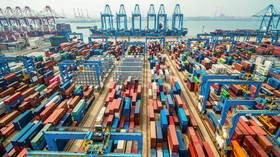Exports from China’s Xinjiang province to US more than doubled this year despite sanctions

Direct exports from China’s northwestern Xinjiang region to the US surged 113% year-on-year in the first quarter of 2021 despite Washington’s import ban on cotton and other products.
Xinjiang’s American-bound exports amounted to $64.4 million in the first three months of 2021, the South China Morning Post reported, citing data from China’s customs agency. While year-on-year data is not representative as it comes from the pandemic year’s low base, exports also rose compared to pre-crisis levels. They gained 46.5% compared with the first quarter of 2019.
Overall exports from the Chinese region in the first quarter increased by more than a third year-on-year, but were down 6% against the same period of 2019.
Also on rt.com China’s economy sees record growth after Covid-19 pandemic slumpWhile Xinjiang’s exports are just a fraction of the growing Chinese exports, the news comes as Beijing and Washington have been locking horns over claims of human rights violations and abuses, including forced labor, in the region. This has resulted in a US ban on all imports of Xinjiang-grown cotton and tomatoes, including sauces, seeds, and other products. China has repeatedly denied the accusations and said it would welcome a UN visit to the region.
However, banned cotton products, except for some garments, are not among the increased exports from the region, according to the report. Xinjiang mostly shipped heterocyclic compounds to the US, which are used in cancer drugs, and amino acids.
Also on rt.com China outpaces US as Europe’s largest trade partner in 2020As tensions between the world’s largest economies rise, the US is considering a ban on the import of all goods from the region unless there is evidence that the product was made without forced labor. Despite the relatively small level of exports from Xinjiang, broader sanctions could affect US consumers, the lead analyst for global trade at the Economist Intelligence Unit, Nick Marro, believes.
“It at least demonstrates that, as tensions mount over Xinjiang, and if trade restrictions multiply, it’ll be a painful process for a lot of US-based customers to meaningfully ‘de-Xinjiangise’ their supply chains,” he told the South China Morning Post.
For more stories on economy & finance visit RT's business section













